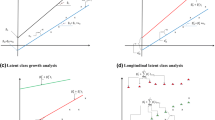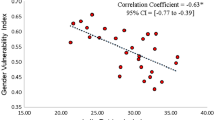Abstract
We apply cohort techniques to monitor four indicators of socio-demographic risk crucial to family wellbeing; namely, income, employment, education, and housing. The data were derived from New Zealand’s five-yearly Census for the period 1981–2006. This allowed us to track birth cohorts of mothers (and their families) over six successive New Zealand censuses focusing on the main childrearing ages of 20–59. This produced ten cohorts—termed “open familial cohorts”—ranging from mothers born in the period 1932–1937 through to 1977–1981. We present age, period and cohort analyses. Families in which the mother is in her early 20s were the most vulnerable, with the lowest incomes, the greatest risk of worklessnes, and the lowest levels of home ownership. Of particular interest is that those in the most recent cohorts—born since 1967—were worse off compared to earlier cohorts. The period from the mid-1980s to the mid-to-late 1990s was one of greatest “socio-demographic risk”, with the lowest work, income and education prospects over the 25 years. The picture on generational profiles was mixed. Contrary to popular mythology the “baby-boomer” cohorts did not enjoy an unqualified advantage over others; indeed the most recent cohorts were doing well, with relatively high incomes, education and work levels. The analysis is successful in identifying age and period effects over a period of major social change, and in documenting cohort experiences for each indicator, thus demonstrating the potential of constructing cohorts from routinely-collected census micro-data for monitoring and policy purposes.
Similar content being viewed by others
Notes
In the Census, a dwelling is ‘any building or structure, or part thereof, that is used (or intended to be used) for the purpose of human habitation’ (Statistics New Zealand 2001a, p. 23).
For information on census coverage, see (Statistics New Zealand 2001a).
The main age-group of first birth for all women in the 1960s and 70s was 20–24; 72% of first births were to women under 25 years in 1971, falling to just 14% in 2001 (Statistics New Zealand 2008). Because of the relationship between early childbearing and lower educational achievement, those women who are now mothers by 20–24 are mostly from lower socio-economic groups. Thus women aged 20–24 in the 2006 census with no qualification were twice as likely to be mothers as those with graduate degrees (96–47% (Khawaja 2007)).
References
Bonoli, G. (2005). The politics of the new social policies: Providing coverage against new social risks in mature welfare states. Policy and Politics, 33(3), 431–449.
Callister, P. (2007). Are New Zealanders heading for older age richer, better educated and more likely to be employed? In J. Boston & J. Davey (Eds.), Implications of population ageing—opportunities and risks (pp. 51–98). Wellington NZ: Institute of Policy Studies, Victoria University of Wellington.
Cotterell, G., Wheldon, M., & Milligan, S. (2008). Measuring changes in family wellbeing in New Zealand 1981–2006. Social Indicators Research, 86, 453–467.
Deaton, A. (1997). The analysis of household surveys: A microeconomic approach to development policy. Baltimore MD: Johns Hopkins University Press.
Esping-Andersen, G. (2000). The sustainability of welfare states into the twenty-first century. International Journal of Health Services, 30(1), 1–12.
Fajth, G. (2000). Regional monitoring of child and family well-being: UNICEF’s MONEE project CEE and CIS in a comparative perspective. Statistical Journal of the United Nations Commission for Europe, 17(1), 75–99.
Glenn, N. D. (2005). Cohort analysis (2nd ed. Vol. 5). Thousand oaks, CA: Sage Publications, Inc.
Humpage, L. (2010). Revisioning comparative welfare state studies: An ‘indigenous dimension’. Policy Studies, 31(5), 539–557.
Jensen, J. (1988). Income equivalences and the estimation of family expenditure on children. (Unpublished Note). Wellington, NZ: Department of Social Welfare.
Khawaja, M. (2007). Growing childlessness and declining cohort fertility in New Zealand. Paper presented at population association of New Zealand conference, Wellington, July 2007.
Milligan, S., Fabian, A., Coope, P., & Errington, C. (2006). Family wellbeing indicators from the 1981–2001 New Zealand censuses. Wellington: Statistics New Zealand.
Moore, K. A., Vandivere, S., & Redd, Z. (2006). A sociodemographic risk index. Social Indicators Research, 75(1), 45–81.
Myers, D. (1999). Cohort longitudinal estimation of housing careers. Housing Studies, 14(4), 473–490.
Ryder, N. (1965). The cohort as a concept in the study of social change. American Sociological Review, 30(6), 843–861.
Statistics New Zealand. (1999a). Statistical standard for dwelling type. Wellington NZ: Statistics New Zealand.
Statistics New Zealand. (1999b). Statistical standard for family type. Wellington: Statistics New Zealand.
Statistics New Zealand. (1999c). Statistical standard for household composition. Wellington NZ: Statistics New Zealand.
Statistics New Zealand. (2001a). New Zealand census of population and dwellings 2001: Definitions and questionnaires. Wellington NZ: Statistics New Zealand.
Statistics New Zealand. (2001b). Introduction to the census (2001)–reference report. Wellington NZ: Statistics New Zealand.
Statistics New Zealand. (2005). Consumers Price Index—Information releases. Consumers Price Index, 2005. http://www.stats.govt.nz/products-and-services/info-releases/cpi-info-releases.htm. Accessed Aug 31, 2008.
Statistics New Zealand. (2008). Demographic trends 2007. http://www.stats.govt.nz/browse_for_stats/population/estimates_and_projections/demographic-trends-2007.aspx. Accessed April 2, 2011.
Wheldon, M. (2008). FWWP Cohort modelling brief. COMPASS Working paper. http://www.nzssds.org.nz/cohortmodelling. Accessed April 2, 2011.
Acknowledgments
The data for this paper were generated under the Family Whānau and Wellbeing Project (FWWP) which was funded by the Foundation for Research, Science and Technology. Access to the data used in this study was provided by Statistics New Zealand in a secure environment designed to give effect to the confidentiality provisions of the Statistics Act 1975. This study would not have been possible without the generous assistance of Statistics New Zealand. The views expressed in this occasional paper are the personal views of the authors and should not be taken to represent the views or policy of Statistics New Zealand or the Government. We are grateful to Professor Natalie Jackson, Roy Lay-Yee and Dr. Gerry Cotterell for comments on earlier drafts of this paper.
Author information
Authors and Affiliations
Corresponding author
Appendix
Appendix
1.1 Analytical Methods
Table 14 is an example of the presentation of age and period data, with census years across the columns and age-groups down the rows. The mean for each census year across all ages is shown in the bottom row. The mean for each age-group over all census years is shown in the right-hand column. In an age-by-period table, cohort data appear on the diagonals. The first cell contains the data for those aged 20–24 in 1981 (that is, the cohort born 1957–1961). Following the arrow down the diagonal, one can see the data for this cohort at the next census in 1986 at age 25–29, and so on through the life-course. Because it is difficult to read information along diagonals, we move to a cohort-by-age table (Table 15) after the interpretation of age and period effects.
Figure 1 illustrates the patterns in the age and period data in Table 14 It shows the declining proportion of families without their own home as age of mother increases. It also shows the period effect of an increasing proportion within each age-group who are not home-owners after 1991.
Table 15 presents the same data in the format of a cohort table. Data for the birth cohorts appear across the columns and the age-groups down the rows. The period data now appear on the diagonals. Thus we can read the table along the rows to see how each cohort performed at the same age in different periods. And we can read down the columns to see how each cohort performed as it proceeded through the life-course. Different cohorts may hit their peaks and troughs at different ages if there is a strong period effect. On other indicators, the age effect is so strong that all cohorts peak at a particular age, regardless of reaching that age in different periods.
Cohort comparison is made difficult by two factors. Firstly, as already identified above, there is a strong age effect (i.e. home ownership is strongly determined by life-course stage). Secondly, none of the cohorts contains the same range of age-groups, with the earliest cohorts covering only the older ages, and the most recent cohorts only the youngest. Thus it is not possible to use the same approach with cohort comparisons as with period and age outcomes (that is, a summary statistic such as a weighted mean for each cohort).
One approach to cohort comparison designed to overcome the problem of variable age composition is to compare cohorts within age-groups. This can be seen by looking along the rows for each age-group in Table 15. For example it is possible to discern the period effect of highest home ownership in 1991—these are the values that are italicized.
We can also see that at all ages, home ownership declined for successive cohorts after the peak period of 1991; that is, the proportions not in owner-occupied housing (the values in the table) increased.
Cohort analysis also involves reading down the columns to see each cohort’s pattern over the life-course. For example, looking down the column for the cohort born 1952–1956, we see that home ownership was highest in the 35–44 age-groups. By comparison, for the cohort born 1937–1941 home ownership was highest in the 50–54 age-group. Looking at Table 15 we can see that both of these figures occurred in 1991, after which home ownership began to decline. Thus different cohorts have different experiences depending on the age they were at the time of a major “period effect”.
Rights and permissions
About this article
Cite this article
Davis, P., McPherson, M., Wheldon, M. et al. Monitoring Socio-demographic Risk: A Cohort Analysis of Families Using Census Micro-Data. Soc Indic Res 108, 111–130 (2012). https://doi.org/10.1007/s11205-011-9869-7
Accepted:
Published:
Issue Date:
DOI: https://doi.org/10.1007/s11205-011-9869-7





